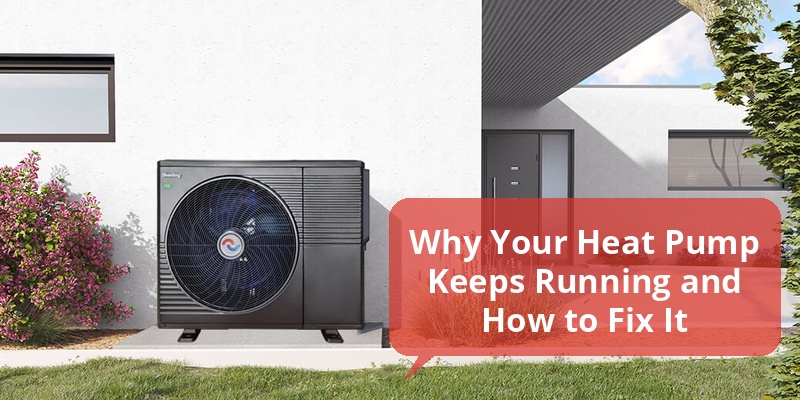When a heat pump continuously runs without cycling off, it can be concerning for homeowners who rely on it for efficient heating and cooling. Several factors may cause this issue, ranging from thermostat settings to mechanical malfunctions. Understanding why a heat pump keeps running is crucial for maintaining energy efficiency and preventing excessive wear. This article explores the common reasons behind persistent operation, highlights diagnostic tips, and offers practical solutions to restore proper function.
| Common Causes | Typical Symptoms | Recommended Actions |
|---|---|---|
| Thermostat Issues | Frequent temperature overshooting, no cycling | Check calibration, replace batteries, or upgrade thermostat |
| Dirty Air Filters | Reduced airflow, longer run times | Clean or replace filters regularly |
| Refrigerant Problems | Inadequate heating/cooling, compressor runs longer | Professional refrigerant check and recharge |
| Faulty Components | Unusual noises, continuous operation | Inspect and repair or replace parts like compressors or sensors |
| Improper System Size | System running continuously to meet demand | Consult HVAC professional for system evaluation |
How Heat Pumps Work and Why Cycling Matters
Heat pumps operate by transferring heat between indoor and outdoor environments using refrigeration cycles. They typically cycle on and off to maintain the set indoor temperature efficiently. When functioning correctly, cycling helps conserve energy and extends the system’s lifespan by preventing continuous strain on components. A heat pump that keeps running may indicate a problem affecting performance or comfort.
Thermostat Settings and Malfunctions
The thermostat controls when a heat pump turns on and off. Incorrect settings such as continuous fan mode, highly sensitive temperature differentials, or improper programming can cause the heat pump to run nonstop. Additionally, a malfunctioning thermostat may fail to send the correct signals. Check for thermostat errors by ensuring it is set to “auto” fan mode and verifying temperature calibration.
How to Troubleshoot Thermostat Problems
- Replace thermostat batteries if low power is suspected.
- Inspect wiring connections for damage or loose contacts.
- Consider upgrading to a smart thermostat for improved control.
Dirty or Clogged Air Filters
Air filters trap dust and debris from entering the heat pump system. When filters become clogged, airflow decreases significantly, forcing the heat pump to run longer to reach desired temperatures. Regular filter maintenance is essential to ensure efficient cycling and prevent extended run times.
Filter Care Best Practices
- Inspect filters monthly during peak use seasons.
- Replace filters every 1 to 3 months depending on usage and environmental factors.
- Use high-quality filters compatible with your heat pump model.
Refrigerant Level and Leak Issues
Refrigerant is the vital fluid that absorbs and releases heat in a heat pump. Low refrigerant levels caused by leaks reduce heat transfer efficiency, creating longer run times as the system struggles to meet heating or cooling demands. Signs include poor temperature output and increased energy bills.
Addressing Refrigerant Problems
- Have a qualified HVAC technician inspect for leaks using specialized equipment.
- Only certified professionals should repair leaks and recharge refrigerant.
- Regular maintenance helps detect refrigerant issues early.
Mechanical and Component Failures
Worn or damaged components such as compressors, sensors, or defrost controls can disrupt normal heat pump operation, leading to constant running. For example, a faulty defrost sensor may cause the system to run continuously even when not needed. Professional diagnosis can identify and resolve these hardware issues.
Common Mechanical Problems
- Compressor issues causing inefficient pressure cycling.
- Malfunctioning reversing valves stuck in one mode.
- Broken fan motors or capacitors affecting airflow and temperature control.
Incorrect Heat Pump Sizing and Installation
An oversized or undersized heat pump may run excessively. Oversized units cycle on and off too rapidly, while undersized units run longer trying to meet heating or cooling requirements. Improper installation, such as poor ductwork design, can also lead to prolonged run time. Proper sizing by an HVAC professional ensures optimal performance.
Key Considerations for Proper Sizing
- Use Manual J load calculation for accurate size estimation.
- Account for insulation, climate, house orientation, and occupancy.
- Ensure ducts are sealed and appropriately sized to reduce system strain.
Additional Factors Affecting Heat Pump Run Time
Other factors such as extreme outdoor temperatures, frequent temperature changes, or improper usage habits can contribute to longer heat pump cycles. For instance, in very cold conditions, the heat pump may need to run continuously or engage auxiliary heat to maintain warmth.
- Check for drafts or poor insulation that increases heating/cooling load.
- Avoid frequent manual adjustments of thermostat setpoints.
- Consider supplemental heating during extreme cold.
When to Call a Professional HVAC Technician
If troubleshooting basic issues like thermostat settings or filter replacement does not resolve the problem, it’s important to get professional help. Technicians can perform comprehensive diagnostics including refrigerant charge checks, electrical system tests, and component analyses. Early intervention can prevent costly repairs and improve system lifespan.
| Signs to Contact a Professional | Possible Diagnoses |
|---|---|
| Heat pump runs continuously with no temperature improvement | Refrigerant leak, compressor failure, faulty control board |
| Unusual noises or vibrations | Worn fan motor, loose parts, compressor damage |
| Thermostat displays errors or fails to control system | Thermostat malfunction, wiring issues |
